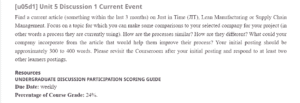Current Event on Supply Chain Management
Boeing, one of the leading aircraft manufacturers, has been in the spotlight for quality issues in the recent past. An Ethiopian Airlines plane crash and another emergency landing of the same aircraft model raised points on the quality of the company’s product, possibly compromising users’ safety. In the article “Boeing’s 5S Problem”, Sliff (2019) evaluates the potential of inefficient lean production being a significant cause of Boeing’s safety issues. The article quotes the president of the Management and Strategy Institute, saying that Boeing has insufficient process control strategies to maximize its products’ quality. For instance, a recently delivered U.S. Army aircraft, KC-46, was found to have tools, litter, and other work materials. Such debris could be a sign of poor quality management and safety issues.
Would you like an initial copy of the “Current Event on Supply Chain Management essay”? Reach out to us.
The article compares the Boeing manufacturing process to that of Toyota, the inventor of the lean manufacturing philosophy, to show the changes that Boeing can make to enhance its quality management. The method comprises 5S, representing actions in the lean manufacturing process. The 5S includes sort-taking stock of all items, setting in order-ensure everything is arranged for ease of use, shine-cleaning the workplace, standardizing-create a uniform approach, and sustain-making the lean manufacturing process regularly.
Connection to Zara’s Manufacturing Process
The ideas presented to Boeing in the article relate slightly to the processes Zara uses in its JIT production. Still, there are also some elements that the company can improve. For instance, Zara begins its operations by sorting by investigating the design and inventory requirements before starting the production process. Additionally, the company has a standardized production process that ensures the consistent production of the same quality of products. As the article recommends, Zara has also sustained its supply chain management strategies. It ensures that all employees understand and use the production process consistently for consistent quality production. What Zara can learn from this is the idea of cleaning up the workplace to prevent any mistakes that might compromise its quality. In any new production period, the company should ensure that the production plants are cleared of the previous production issues, which can affect current quality. Other than that, Zara is performing a great job in maintaining a lean production system.
Similar Post: Interpersonal Reflection
References
Sliff, M. (2019). Boeing’s 5S Problem. Quality Digest. Retrieved from: https://www.qualitydigest.com/inside/lean-article/boeing-s-5s-problem-042519.html
ORDER A PLAGIARISM-FREE PAPER HERE
We’ll write everything from scratch
Question
[u05d1] Unit 5 Discussion 1 Current Event
Find a current article (something within the last three months) on Just in Time (JIT), Lean Manufacturing, or Supply Chain Management. Focus on a topic you can compare to your selected company for your project (in other words, a process they are currently using).

Current Event on Supply Chain Management
How are the processes similar? How are they different? What could your company incorporate from the article that would help them improve their function? Your initial posting should be approximately 300 to 400 words. Please revisit the Courseroom after your initial posting and respond to at least two other learners’ postings.
Resources
UNDERGRADUATE DISCUSSION PARTICIPATION SCORING GUIDE
Due Date: Weekly
Percentage of Course Grade: 24%.
| Criteria | Distinguished |
| Apply relevant course concepts, theories, or materials correctly. 33% |
Use examples or supporting evidence to analyze course concepts, theories, or materials correctly. |
| Collaborate with fellow learners, relating the discussion to relevant course concepts. 33% |
Collaborates with fellow learners, relating the discussion to relevant course concepts and extending the dialogue. |
| Apply relevant professional, personal, or other real-world experiences. 34% |
Applies relevant professional, personal, or real-world experiences to extend the dialogue. |

